MG411: Individual Research Portfolio on People Management at NHS
VerifiedAdded on 2023/01/11
|9
|2583
|32
Report
AI Summary
This report provides a comprehensive analysis of strategic people management within the National Health Service (NHS). The report is structured around three key areas: leadership and management, training and development, and talent management, all of which are examined within the context of the NHS. The leadership section explores the communication strategies, progressive leadership approaches, and employee grievance mechanisms in place. The training and development section discusses various training programs, including skill development, and theoretical models like the theory of reinforcement, theory of learning, and experiential learning. Finally, the talent management section covers salary structures, employee benefits, and continuous improvement strategies. The report offers recommendations for each area, such as involving employees in policy-making, designing job-specific training, and fostering collaborative partnerships. The report emphasizes the importance of these elements in underpinning performance management and creating a positive work environment within the NHS.
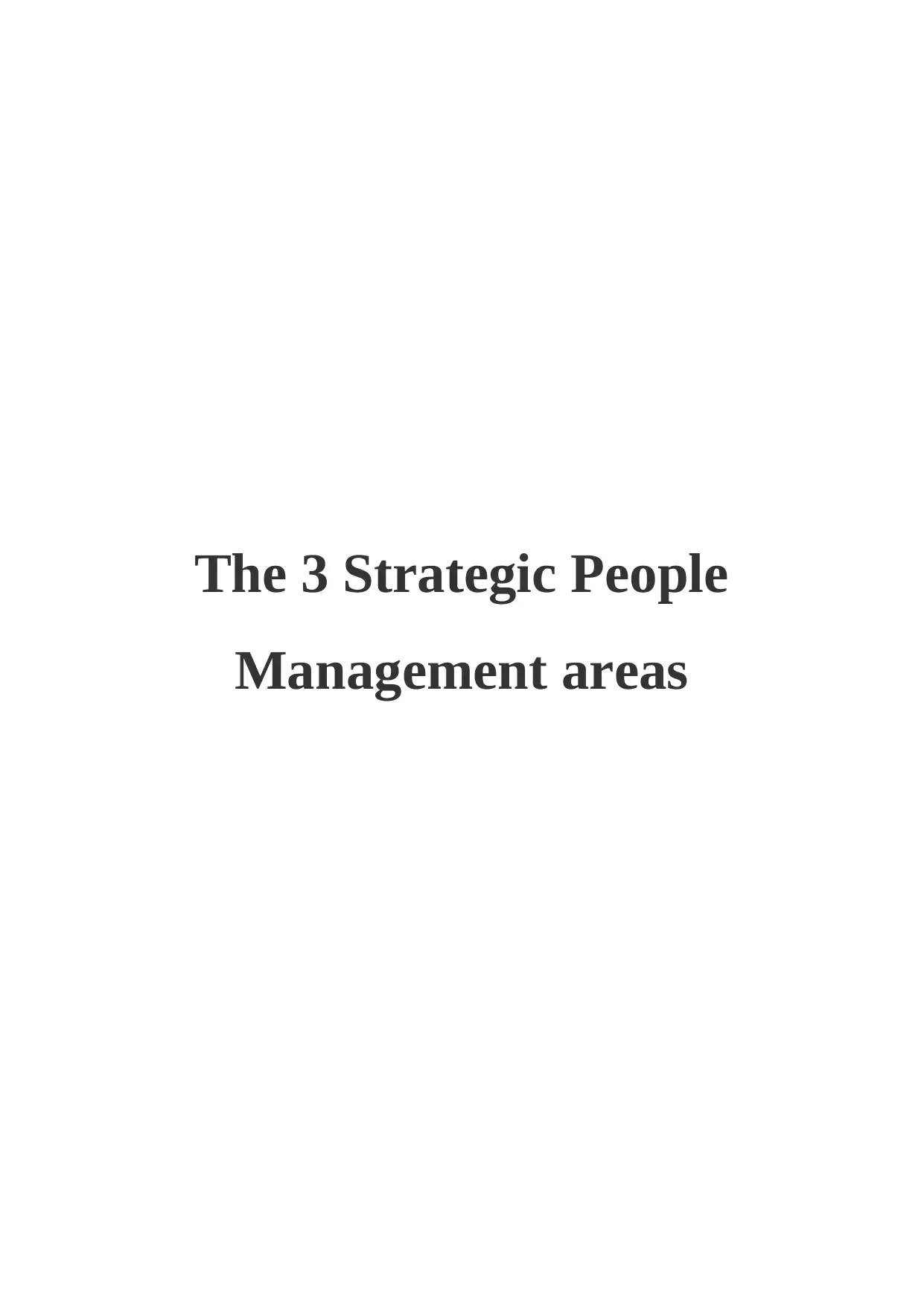
The 3 Strategic People
Management areas
Management areas
Paraphrase This Document
Need a fresh take? Get an instant paraphrase of this document with our AI Paraphraser
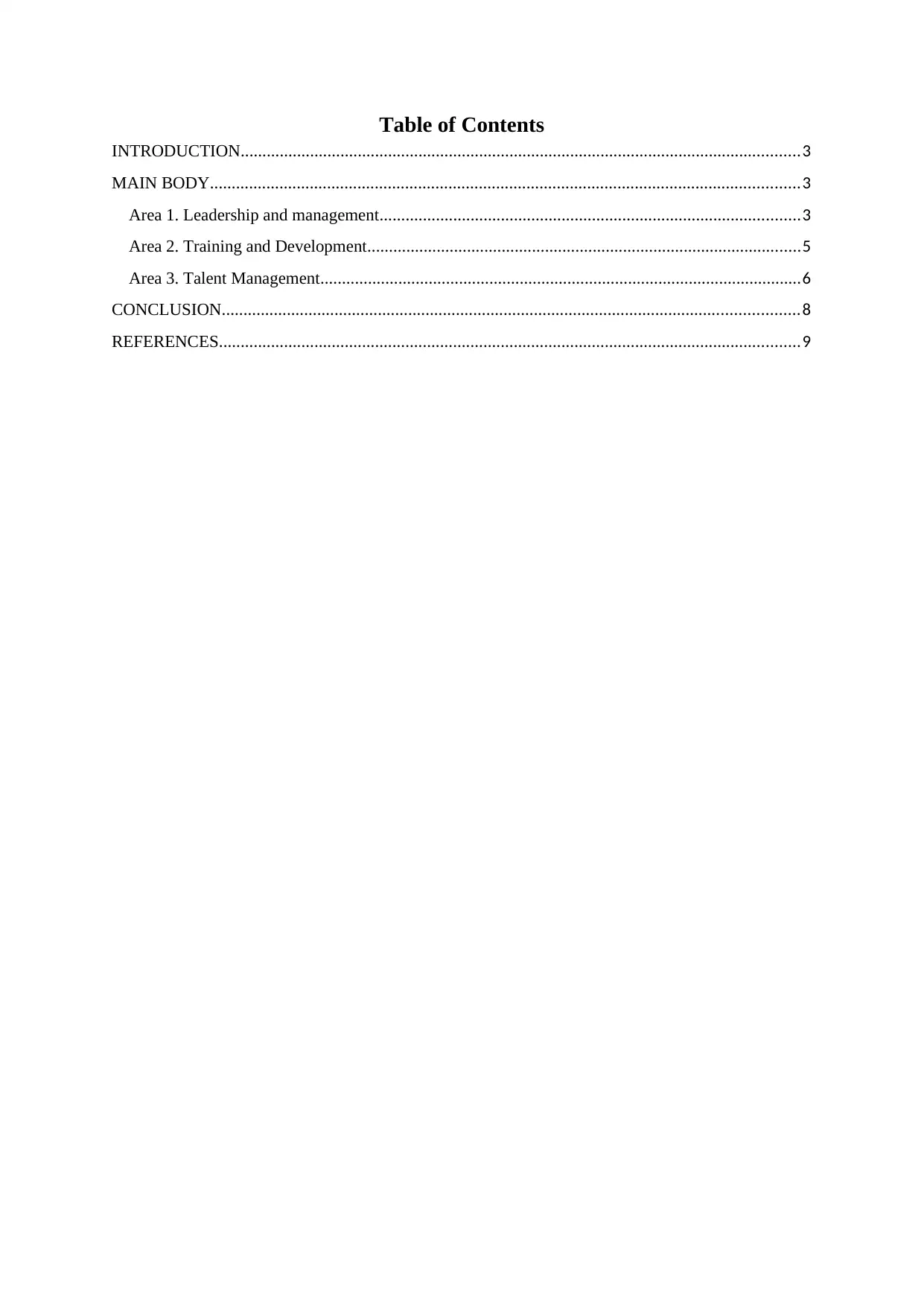
Table of Contents
INTRODUCTION.................................................................................................................................3
MAIN BODY........................................................................................................................................3
Area 1. Leadership and management.................................................................................................3
Area 2. Training and Development....................................................................................................5
Area 3. Talent Management...............................................................................................................6
CONCLUSION.....................................................................................................................................8
REFERENCES......................................................................................................................................9
INTRODUCTION.................................................................................................................................3
MAIN BODY........................................................................................................................................3
Area 1. Leadership and management.................................................................................................3
Area 2. Training and Development....................................................................................................5
Area 3. Talent Management...............................................................................................................6
CONCLUSION.....................................................................................................................................8
REFERENCES......................................................................................................................................9
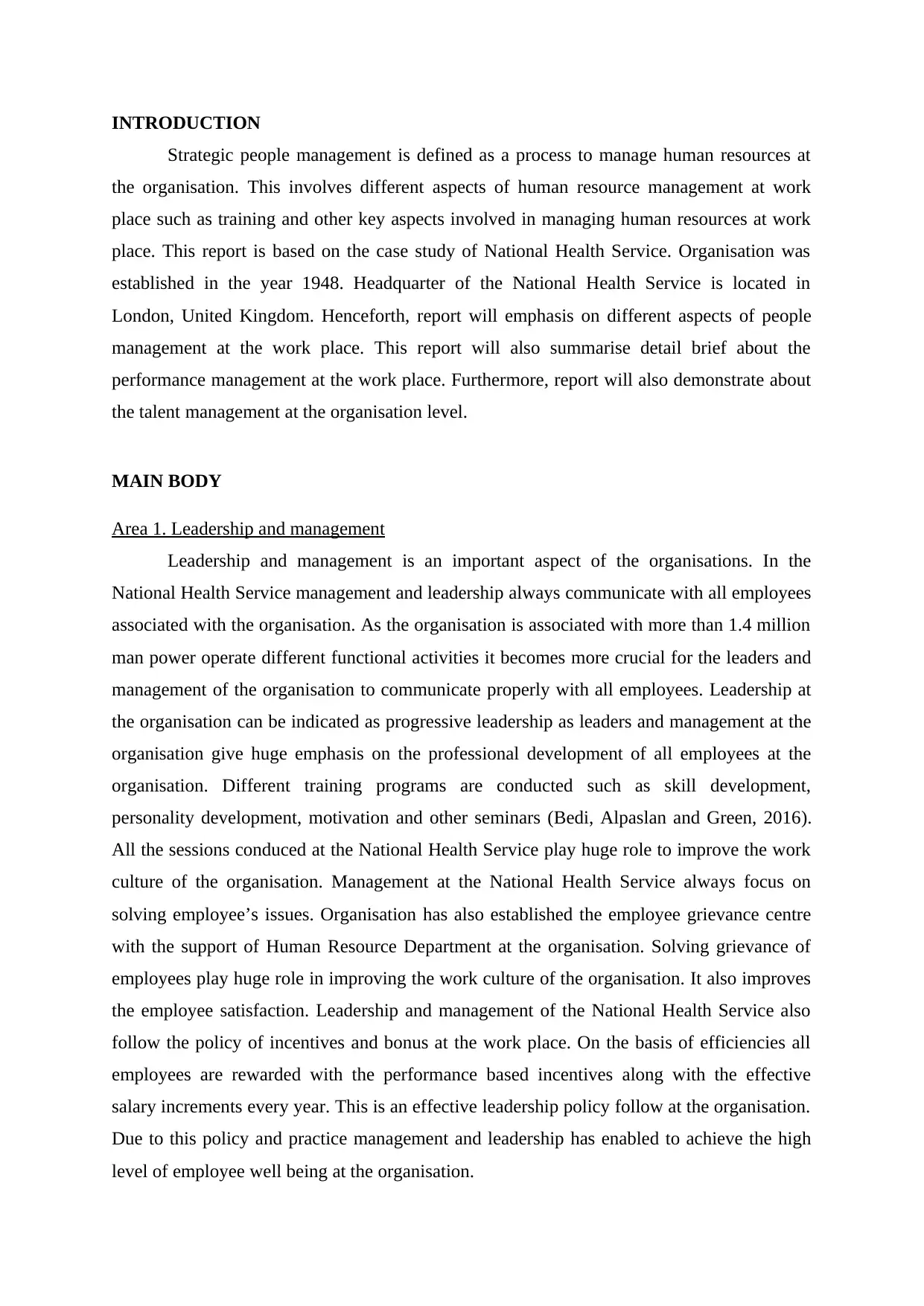
INTRODUCTION
Strategic people management is defined as a process to manage human resources at
the organisation. This involves different aspects of human resource management at work
place such as training and other key aspects involved in managing human resources at work
place. This report is based on the case study of National Health Service. Organisation was
established in the year 1948. Headquarter of the National Health Service is located in
London, United Kingdom. Henceforth, report will emphasis on different aspects of people
management at the work place. This report will also summarise detail brief about the
performance management at the work place. Furthermore, report will also demonstrate about
the talent management at the organisation level.
MAIN BODY
Area 1. Leadership and management
Leadership and management is an important aspect of the organisations. In the
National Health Service management and leadership always communicate with all employees
associated with the organisation. As the organisation is associated with more than 1.4 million
man power operate different functional activities it becomes more crucial for the leaders and
management of the organisation to communicate properly with all employees. Leadership at
the organisation can be indicated as progressive leadership as leaders and management at the
organisation give huge emphasis on the professional development of all employees at the
organisation. Different training programs are conducted such as skill development,
personality development, motivation and other seminars (Bedi, Alpaslan and Green, 2016).
All the sessions conduced at the National Health Service play huge role to improve the work
culture of the organisation. Management at the National Health Service always focus on
solving employee’s issues. Organisation has also established the employee grievance centre
with the support of Human Resource Department at the organisation. Solving grievance of
employees play huge role in improving the work culture of the organisation. It also improves
the employee satisfaction. Leadership and management of the National Health Service also
follow the policy of incentives and bonus at the work place. On the basis of efficiencies all
employees are rewarded with the performance based incentives along with the effective
salary increments every year. This is an effective leadership policy follow at the organisation.
Due to this policy and practice management and leadership has enabled to achieve the high
level of employee well being at the organisation.
Strategic people management is defined as a process to manage human resources at
the organisation. This involves different aspects of human resource management at work
place such as training and other key aspects involved in managing human resources at work
place. This report is based on the case study of National Health Service. Organisation was
established in the year 1948. Headquarter of the National Health Service is located in
London, United Kingdom. Henceforth, report will emphasis on different aspects of people
management at the work place. This report will also summarise detail brief about the
performance management at the work place. Furthermore, report will also demonstrate about
the talent management at the organisation level.
MAIN BODY
Area 1. Leadership and management
Leadership and management is an important aspect of the organisations. In the
National Health Service management and leadership always communicate with all employees
associated with the organisation. As the organisation is associated with more than 1.4 million
man power operate different functional activities it becomes more crucial for the leaders and
management of the organisation to communicate properly with all employees. Leadership at
the organisation can be indicated as progressive leadership as leaders and management at the
organisation give huge emphasis on the professional development of all employees at the
organisation. Different training programs are conducted such as skill development,
personality development, motivation and other seminars (Bedi, Alpaslan and Green, 2016).
All the sessions conduced at the National Health Service play huge role to improve the work
culture of the organisation. Management at the National Health Service always focus on
solving employee’s issues. Organisation has also established the employee grievance centre
with the support of Human Resource Department at the organisation. Solving grievance of
employees play huge role in improving the work culture of the organisation. It also improves
the employee satisfaction. Leadership and management of the National Health Service also
follow the policy of incentives and bonus at the work place. On the basis of efficiencies all
employees are rewarded with the performance based incentives along with the effective
salary increments every year. This is an effective leadership policy follow at the organisation.
Due to this policy and practice management and leadership has enabled to achieve the high
level of employee well being at the organisation.
⊘ This is a preview!⊘
Do you want full access?
Subscribe today to unlock all pages.

Trusted by 1+ million students worldwide
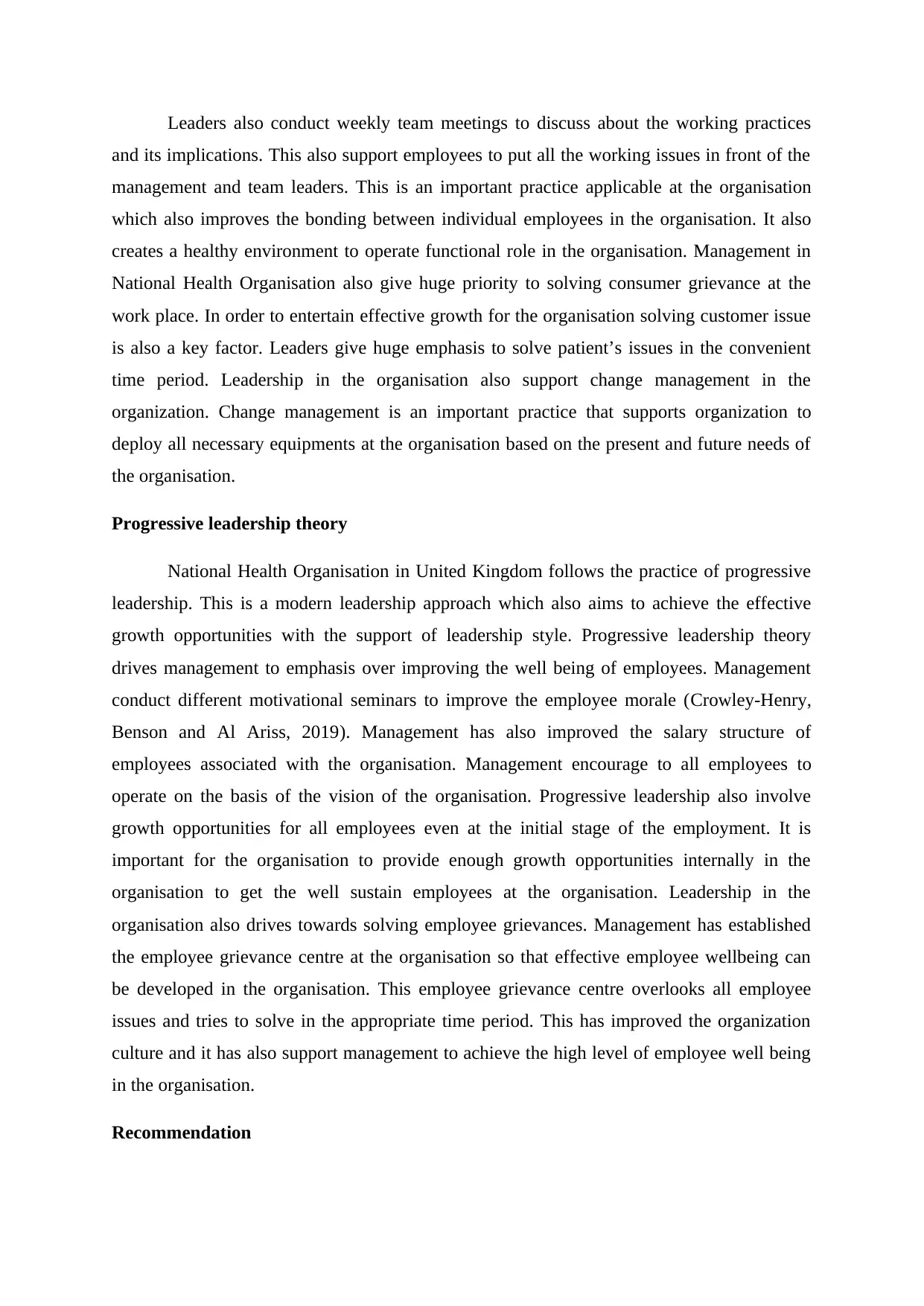
Leaders also conduct weekly team meetings to discuss about the working practices
and its implications. This also support employees to put all the working issues in front of the
management and team leaders. This is an important practice applicable at the organisation
which also improves the bonding between individual employees in the organisation. It also
creates a healthy environment to operate functional role in the organisation. Management in
National Health Organisation also give huge priority to solving consumer grievance at the
work place. In order to entertain effective growth for the organisation solving customer issue
is also a key factor. Leaders give huge emphasis to solve patient’s issues in the convenient
time period. Leadership in the organisation also support change management in the
organization. Change management is an important practice that supports organization to
deploy all necessary equipments at the organisation based on the present and future needs of
the organisation.
Progressive leadership theory
National Health Organisation in United Kingdom follows the practice of progressive
leadership. This is a modern leadership approach which also aims to achieve the effective
growth opportunities with the support of leadership style. Progressive leadership theory
drives management to emphasis over improving the well being of employees. Management
conduct different motivational seminars to improve the employee morale (Crowley‐Henry,
Benson and Al Ariss, 2019). Management has also improved the salary structure of
employees associated with the organisation. Management encourage to all employees to
operate on the basis of the vision of the organisation. Progressive leadership also involve
growth opportunities for all employees even at the initial stage of the employment. It is
important for the organisation to provide enough growth opportunities internally in the
organisation to get the well sustain employees at the organisation. Leadership in the
organisation also drives towards solving employee grievances. Management has established
the employee grievance centre at the organisation so that effective employee wellbeing can
be developed in the organisation. This employee grievance centre overlooks all employee
issues and tries to solve in the appropriate time period. This has improved the organization
culture and it has also support management to achieve the high level of employee well being
in the organisation.
Recommendation
and its implications. This also support employees to put all the working issues in front of the
management and team leaders. This is an important practice applicable at the organisation
which also improves the bonding between individual employees in the organisation. It also
creates a healthy environment to operate functional role in the organisation. Management in
National Health Organisation also give huge priority to solving consumer grievance at the
work place. In order to entertain effective growth for the organisation solving customer issue
is also a key factor. Leaders give huge emphasis to solve patient’s issues in the convenient
time period. Leadership in the organisation also support change management in the
organization. Change management is an important practice that supports organization to
deploy all necessary equipments at the organisation based on the present and future needs of
the organisation.
Progressive leadership theory
National Health Organisation in United Kingdom follows the practice of progressive
leadership. This is a modern leadership approach which also aims to achieve the effective
growth opportunities with the support of leadership style. Progressive leadership theory
drives management to emphasis over improving the well being of employees. Management
conduct different motivational seminars to improve the employee morale (Crowley‐Henry,
Benson and Al Ariss, 2019). Management has also improved the salary structure of
employees associated with the organisation. Management encourage to all employees to
operate on the basis of the vision of the organisation. Progressive leadership also involve
growth opportunities for all employees even at the initial stage of the employment. It is
important for the organisation to provide enough growth opportunities internally in the
organisation to get the well sustain employees at the organisation. Leadership in the
organisation also drives towards solving employee grievances. Management has established
the employee grievance centre at the organisation so that effective employee wellbeing can
be developed in the organisation. This employee grievance centre overlooks all employee
issues and tries to solve in the appropriate time period. This has improved the organization
culture and it has also support management to achieve the high level of employee well being
in the organisation.
Recommendation
Paraphrase This Document
Need a fresh take? Get an instant paraphrase of this document with our AI Paraphraser
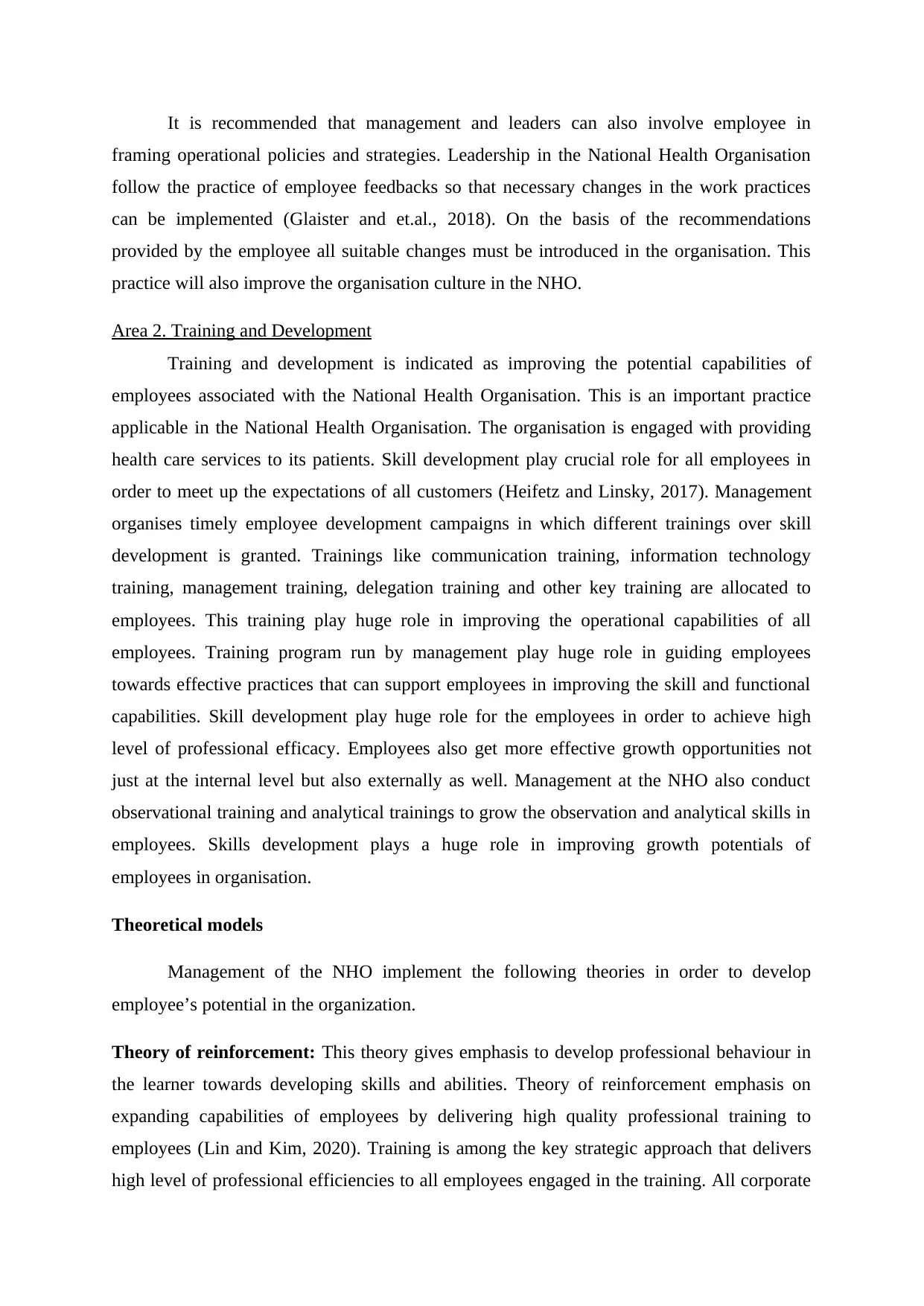
It is recommended that management and leaders can also involve employee in
framing operational policies and strategies. Leadership in the National Health Organisation
follow the practice of employee feedbacks so that necessary changes in the work practices
can be implemented (Glaister and et.al., 2018). On the basis of the recommendations
provided by the employee all suitable changes must be introduced in the organisation. This
practice will also improve the organisation culture in the NHO.
Area 2. Training and Development
Training and development is indicated as improving the potential capabilities of
employees associated with the National Health Organisation. This is an important practice
applicable in the National Health Organisation. The organisation is engaged with providing
health care services to its patients. Skill development play crucial role for all employees in
order to meet up the expectations of all customers (Heifetz and Linsky, 2017). Management
organises timely employee development campaigns in which different trainings over skill
development is granted. Trainings like communication training, information technology
training, management training, delegation training and other key training are allocated to
employees. This training play huge role in improving the operational capabilities of all
employees. Training program run by management play huge role in guiding employees
towards effective practices that can support employees in improving the skill and functional
capabilities. Skill development play huge role for the employees in order to achieve high
level of professional efficacy. Employees also get more effective growth opportunities not
just at the internal level but also externally as well. Management at the NHO also conduct
observational training and analytical trainings to grow the observation and analytical skills in
employees. Skills development plays a huge role in improving growth potentials of
employees in organisation.
Theoretical models
Management of the NHO implement the following theories in order to develop
employee’s potential in the organization.
Theory of reinforcement: This theory gives emphasis to develop professional behaviour in
the learner towards developing skills and abilities. Theory of reinforcement emphasis on
expanding capabilities of employees by delivering high quality professional training to
employees (Lin and Kim, 2020). Training is among the key strategic approach that delivers
high level of professional efficiencies to all employees engaged in the training. All corporate
framing operational policies and strategies. Leadership in the National Health Organisation
follow the practice of employee feedbacks so that necessary changes in the work practices
can be implemented (Glaister and et.al., 2018). On the basis of the recommendations
provided by the employee all suitable changes must be introduced in the organisation. This
practice will also improve the organisation culture in the NHO.
Area 2. Training and Development
Training and development is indicated as improving the potential capabilities of
employees associated with the National Health Organisation. This is an important practice
applicable in the National Health Organisation. The organisation is engaged with providing
health care services to its patients. Skill development play crucial role for all employees in
order to meet up the expectations of all customers (Heifetz and Linsky, 2017). Management
organises timely employee development campaigns in which different trainings over skill
development is granted. Trainings like communication training, information technology
training, management training, delegation training and other key training are allocated to
employees. This training play huge role in improving the operational capabilities of all
employees. Training program run by management play huge role in guiding employees
towards effective practices that can support employees in improving the skill and functional
capabilities. Skill development play huge role for the employees in order to achieve high
level of professional efficacy. Employees also get more effective growth opportunities not
just at the internal level but also externally as well. Management at the NHO also conduct
observational training and analytical trainings to grow the observation and analytical skills in
employees. Skills development plays a huge role in improving growth potentials of
employees in organisation.
Theoretical models
Management of the NHO implement the following theories in order to develop
employee’s potential in the organization.
Theory of reinforcement: This theory gives emphasis to develop professional behaviour in
the learner towards developing skills and abilities. Theory of reinforcement emphasis on
expanding capabilities of employees by delivering high quality professional training to
employees (Lin and Kim, 2020). Training is among the key strategic approach that delivers
high level of professional efficiencies to all employees engaged in the training. All corporate
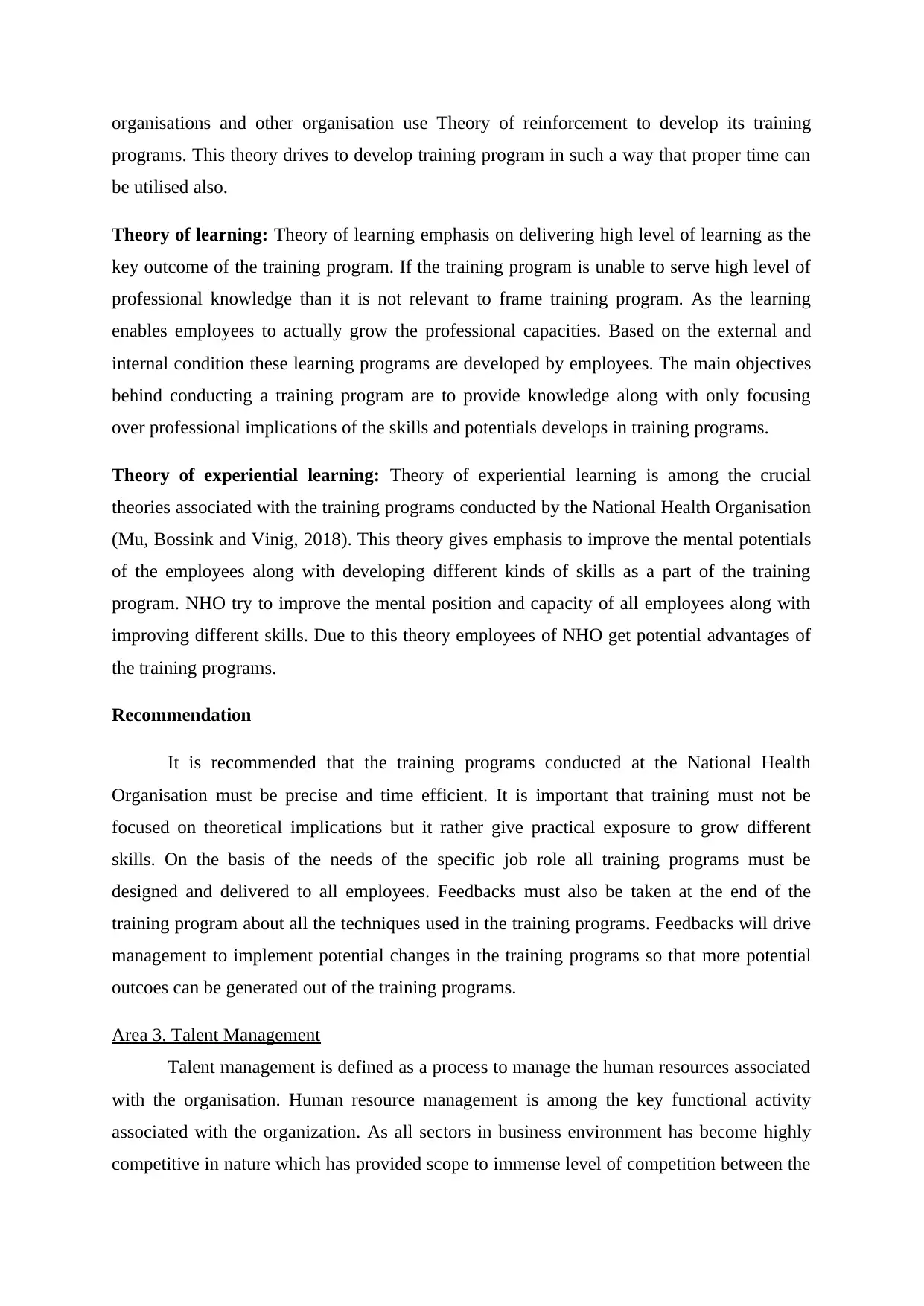
organisations and other organisation use Theory of reinforcement to develop its training
programs. This theory drives to develop training program in such a way that proper time can
be utilised also.
Theory of learning: Theory of learning emphasis on delivering high level of learning as the
key outcome of the training program. If the training program is unable to serve high level of
professional knowledge than it is not relevant to frame training program. As the learning
enables employees to actually grow the professional capacities. Based on the external and
internal condition these learning programs are developed by employees. The main objectives
behind conducting a training program are to provide knowledge along with only focusing
over professional implications of the skills and potentials develops in training programs.
Theory of experiential learning: Theory of experiential learning is among the crucial
theories associated with the training programs conducted by the National Health Organisation
(Mu, Bossink and Vinig, 2018). This theory gives emphasis to improve the mental potentials
of the employees along with developing different kinds of skills as a part of the training
program. NHO try to improve the mental position and capacity of all employees along with
improving different skills. Due to this theory employees of NHO get potential advantages of
the training programs.
Recommendation
It is recommended that the training programs conducted at the National Health
Organisation must be precise and time efficient. It is important that training must not be
focused on theoretical implications but it rather give practical exposure to grow different
skills. On the basis of the needs of the specific job role all training programs must be
designed and delivered to all employees. Feedbacks must also be taken at the end of the
training program about all the techniques used in the training programs. Feedbacks will drive
management to implement potential changes in the training programs so that more potential
outcoes can be generated out of the training programs.
Area 3. Talent Management
Talent management is defined as a process to manage the human resources associated
with the organisation. Human resource management is among the key functional activity
associated with the organization. As all sectors in business environment has become highly
competitive in nature which has provided scope to immense level of competition between the
programs. This theory drives to develop training program in such a way that proper time can
be utilised also.
Theory of learning: Theory of learning emphasis on delivering high level of learning as the
key outcome of the training program. If the training program is unable to serve high level of
professional knowledge than it is not relevant to frame training program. As the learning
enables employees to actually grow the professional capacities. Based on the external and
internal condition these learning programs are developed by employees. The main objectives
behind conducting a training program are to provide knowledge along with only focusing
over professional implications of the skills and potentials develops in training programs.
Theory of experiential learning: Theory of experiential learning is among the crucial
theories associated with the training programs conducted by the National Health Organisation
(Mu, Bossink and Vinig, 2018). This theory gives emphasis to improve the mental potentials
of the employees along with developing different kinds of skills as a part of the training
program. NHO try to improve the mental position and capacity of all employees along with
improving different skills. Due to this theory employees of NHO get potential advantages of
the training programs.
Recommendation
It is recommended that the training programs conducted at the National Health
Organisation must be precise and time efficient. It is important that training must not be
focused on theoretical implications but it rather give practical exposure to grow different
skills. On the basis of the needs of the specific job role all training programs must be
designed and delivered to all employees. Feedbacks must also be taken at the end of the
training program about all the techniques used in the training programs. Feedbacks will drive
management to implement potential changes in the training programs so that more potential
outcoes can be generated out of the training programs.
Area 3. Talent Management
Talent management is defined as a process to manage the human resources associated
with the organisation. Human resource management is among the key functional activity
associated with the organization. As all sectors in business environment has become highly
competitive in nature which has provided scope to immense level of competition between the
⊘ This is a preview!⊘
Do you want full access?
Subscribe today to unlock all pages.

Trusted by 1+ million students worldwide
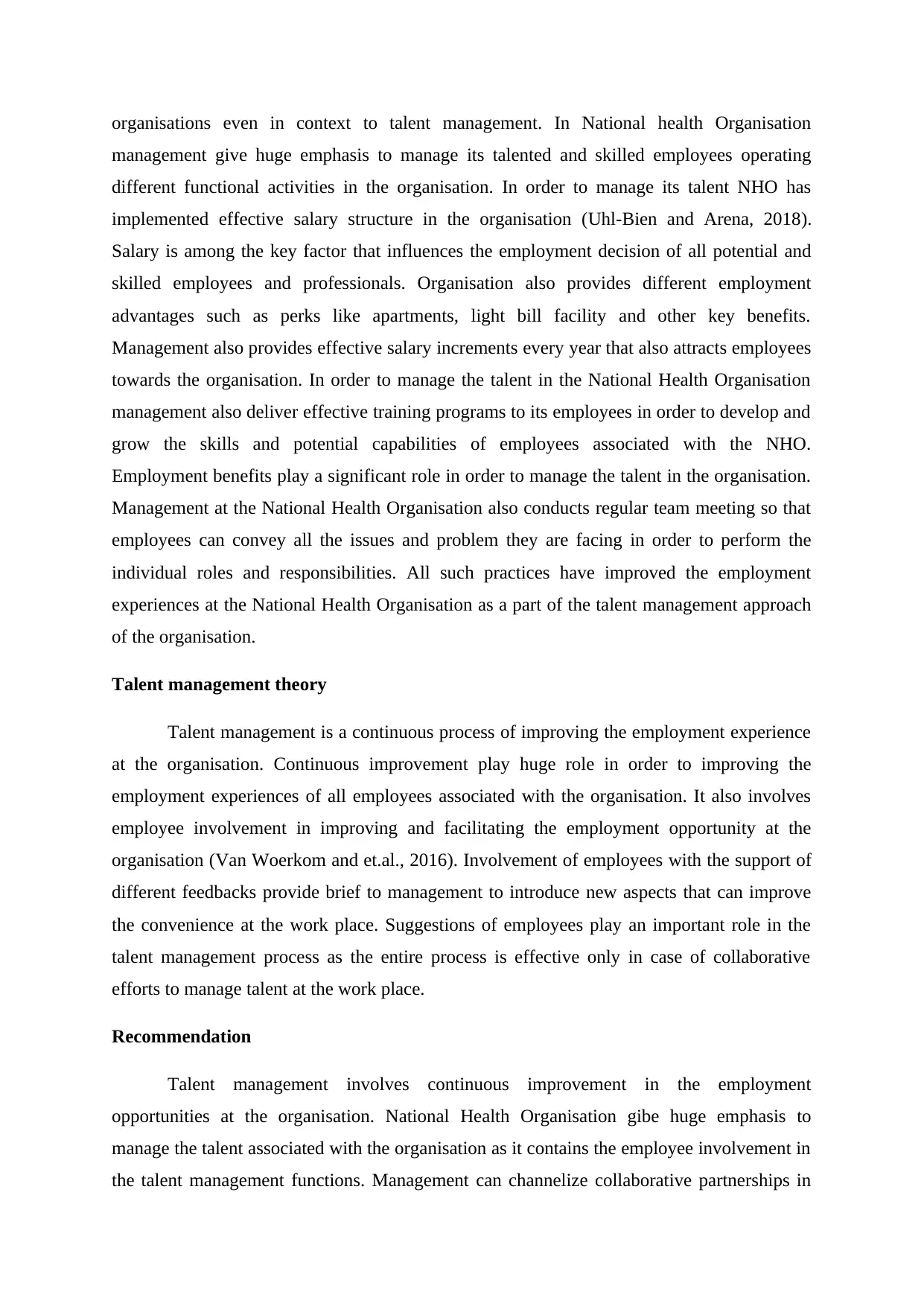
organisations even in context to talent management. In National health Organisation
management give huge emphasis to manage its talented and skilled employees operating
different functional activities in the organisation. In order to manage its talent NHO has
implemented effective salary structure in the organisation (Uhl-Bien and Arena, 2018).
Salary is among the key factor that influences the employment decision of all potential and
skilled employees and professionals. Organisation also provides different employment
advantages such as perks like apartments, light bill facility and other key benefits.
Management also provides effective salary increments every year that also attracts employees
towards the organisation. In order to manage the talent in the National Health Organisation
management also deliver effective training programs to its employees in order to develop and
grow the skills and potential capabilities of employees associated with the NHO.
Employment benefits play a significant role in order to manage the talent in the organisation.
Management at the National Health Organisation also conducts regular team meeting so that
employees can convey all the issues and problem they are facing in order to perform the
individual roles and responsibilities. All such practices have improved the employment
experiences at the National Health Organisation as a part of the talent management approach
of the organisation.
Talent management theory
Talent management is a continuous process of improving the employment experience
at the organisation. Continuous improvement play huge role in order to improving the
employment experiences of all employees associated with the organisation. It also involves
employee involvement in improving and facilitating the employment opportunity at the
organisation (Van Woerkom and et.al., 2016). Involvement of employees with the support of
different feedbacks provide brief to management to introduce new aspects that can improve
the convenience at the work place. Suggestions of employees play an important role in the
talent management process as the entire process is effective only in case of collaborative
efforts to manage talent at the work place.
Recommendation
Talent management involves continuous improvement in the employment
opportunities at the organisation. National Health Organisation gibe huge emphasis to
manage the talent associated with the organisation as it contains the employee involvement in
the talent management functions. Management can channelize collaborative partnerships in
management give huge emphasis to manage its talented and skilled employees operating
different functional activities in the organisation. In order to manage its talent NHO has
implemented effective salary structure in the organisation (Uhl-Bien and Arena, 2018).
Salary is among the key factor that influences the employment decision of all potential and
skilled employees and professionals. Organisation also provides different employment
advantages such as perks like apartments, light bill facility and other key benefits.
Management also provides effective salary increments every year that also attracts employees
towards the organisation. In order to manage the talent in the National Health Organisation
management also deliver effective training programs to its employees in order to develop and
grow the skills and potential capabilities of employees associated with the NHO.
Employment benefits play a significant role in order to manage the talent in the organisation.
Management at the National Health Organisation also conducts regular team meeting so that
employees can convey all the issues and problem they are facing in order to perform the
individual roles and responsibilities. All such practices have improved the employment
experiences at the National Health Organisation as a part of the talent management approach
of the organisation.
Talent management theory
Talent management is a continuous process of improving the employment experience
at the organisation. Continuous improvement play huge role in order to improving the
employment experiences of all employees associated with the organisation. It also involves
employee involvement in improving and facilitating the employment opportunity at the
organisation (Van Woerkom and et.al., 2016). Involvement of employees with the support of
different feedbacks provide brief to management to introduce new aspects that can improve
the convenience at the work place. Suggestions of employees play an important role in the
talent management process as the entire process is effective only in case of collaborative
efforts to manage talent at the work place.
Recommendation
Talent management involves continuous improvement in the employment
opportunities at the organisation. National Health Organisation gibe huge emphasis to
manage the talent associated with the organisation as it contains the employee involvement in
the talent management functions. Management can channelize collaborative partnerships in
Paraphrase This Document
Need a fresh take? Get an instant paraphrase of this document with our AI Paraphraser
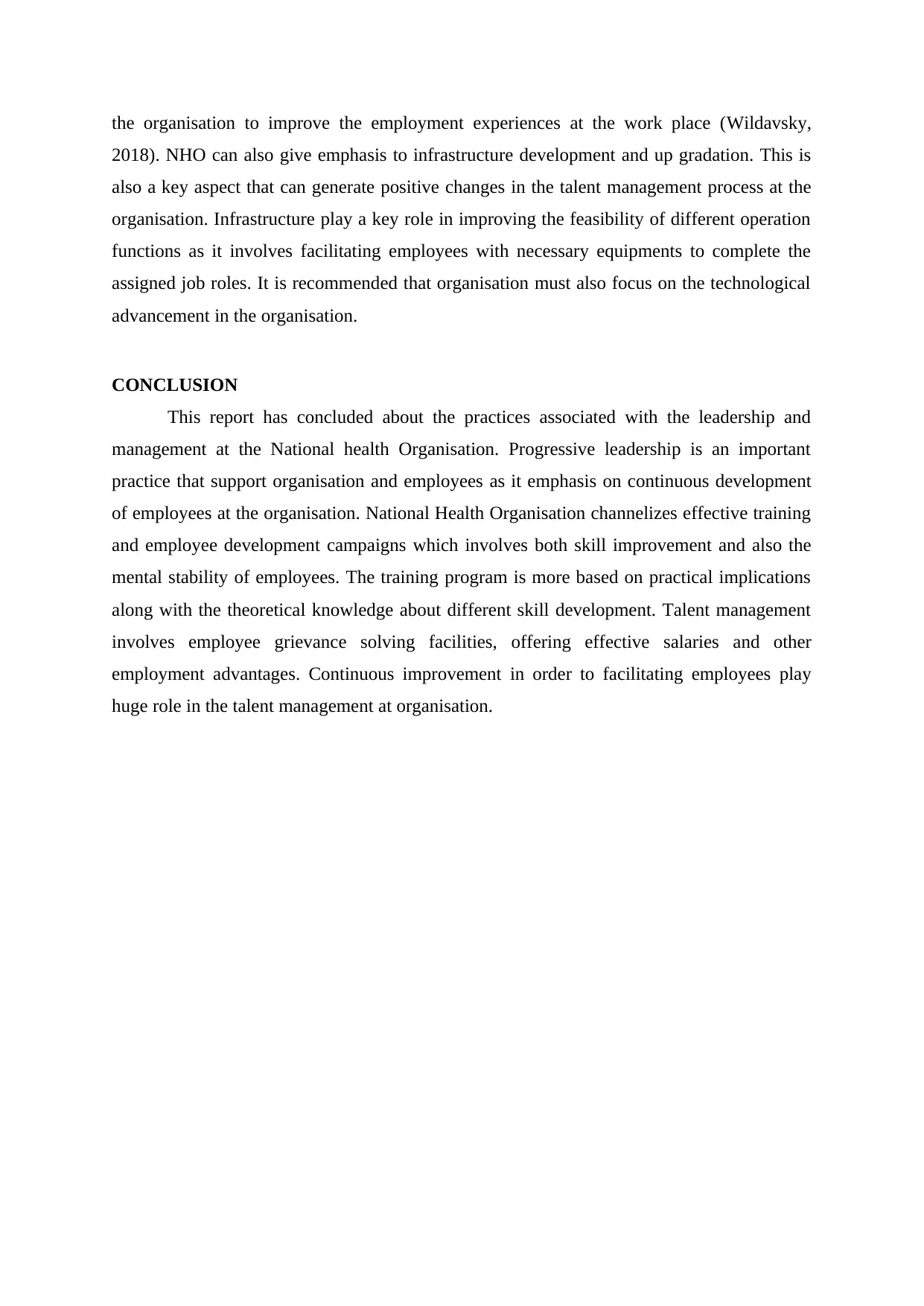
the organisation to improve the employment experiences at the work place (Wildavsky,
2018). NHO can also give emphasis to infrastructure development and up gradation. This is
also a key aspect that can generate positive changes in the talent management process at the
organisation. Infrastructure play a key role in improving the feasibility of different operation
functions as it involves facilitating employees with necessary equipments to complete the
assigned job roles. It is recommended that organisation must also focus on the technological
advancement in the organisation.
CONCLUSION
This report has concluded about the practices associated with the leadership and
management at the National health Organisation. Progressive leadership is an important
practice that support organisation and employees as it emphasis on continuous development
of employees at the organisation. National Health Organisation channelizes effective training
and employee development campaigns which involves both skill improvement and also the
mental stability of employees. The training program is more based on practical implications
along with the theoretical knowledge about different skill development. Talent management
involves employee grievance solving facilities, offering effective salaries and other
employment advantages. Continuous improvement in order to facilitating employees play
huge role in the talent management at organisation.
2018). NHO can also give emphasis to infrastructure development and up gradation. This is
also a key aspect that can generate positive changes in the talent management process at the
organisation. Infrastructure play a key role in improving the feasibility of different operation
functions as it involves facilitating employees with necessary equipments to complete the
assigned job roles. It is recommended that organisation must also focus on the technological
advancement in the organisation.
CONCLUSION
This report has concluded about the practices associated with the leadership and
management at the National health Organisation. Progressive leadership is an important
practice that support organisation and employees as it emphasis on continuous development
of employees at the organisation. National Health Organisation channelizes effective training
and employee development campaigns which involves both skill improvement and also the
mental stability of employees. The training program is more based on practical implications
along with the theoretical knowledge about different skill development. Talent management
involves employee grievance solving facilities, offering effective salaries and other
employment advantages. Continuous improvement in order to facilitating employees play
huge role in the talent management at organisation.
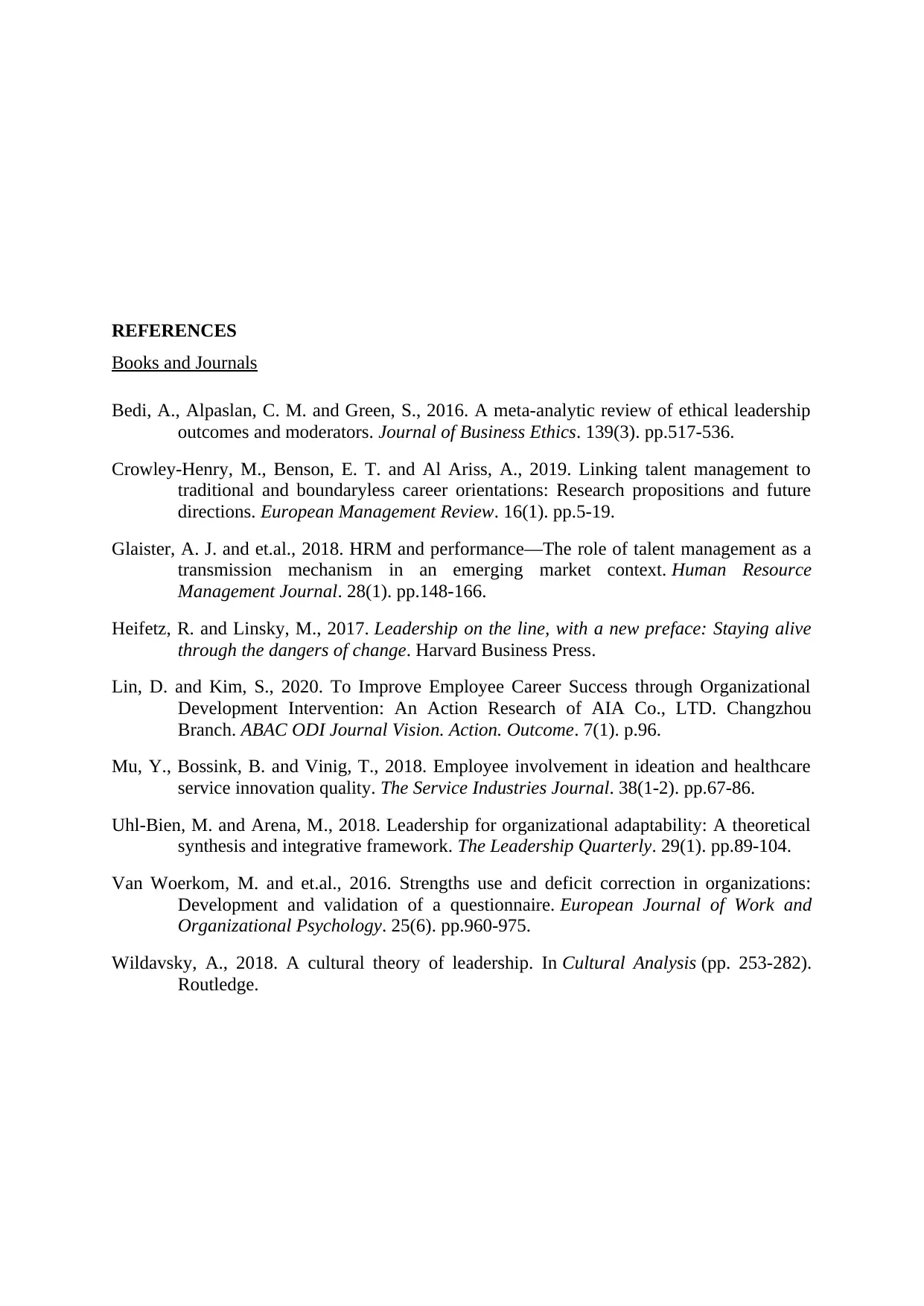
REFERENCES
Books and Journals
Bedi, A., Alpaslan, C. M. and Green, S., 2016. A meta-analytic review of ethical leadership
outcomes and moderators. Journal of Business Ethics. 139(3). pp.517-536.
Crowley‐Henry, M., Benson, E. T. and Al Ariss, A., 2019. Linking talent management to
traditional and boundaryless career orientations: Research propositions and future
directions. European Management Review. 16(1). pp.5-19.
Glaister, A. J. and et.al., 2018. HRM and performance—The role of talent management as a
transmission mechanism in an emerging market context. Human Resource
Management Journal. 28(1). pp.148-166.
Heifetz, R. and Linsky, M., 2017. Leadership on the line, with a new preface: Staying alive
through the dangers of change. Harvard Business Press.
Lin, D. and Kim, S., 2020. To Improve Employee Career Success through Organizational
Development Intervention: An Action Research of AIA Co., LTD. Changzhou
Branch. ABAC ODI Journal Vision. Action. Outcome. 7(1). p.96.
Mu, Y., Bossink, B. and Vinig, T., 2018. Employee involvement in ideation and healthcare
service innovation quality. The Service Industries Journal. 38(1-2). pp.67-86.
Uhl-Bien, M. and Arena, M., 2018. Leadership for organizational adaptability: A theoretical
synthesis and integrative framework. The Leadership Quarterly. 29(1). pp.89-104.
Van Woerkom, M. and et.al., 2016. Strengths use and deficit correction in organizations:
Development and validation of a questionnaire. European Journal of Work and
Organizational Psychology. 25(6). pp.960-975.
Wildavsky, A., 2018. A cultural theory of leadership. In Cultural Analysis (pp. 253-282).
Routledge.
Books and Journals
Bedi, A., Alpaslan, C. M. and Green, S., 2016. A meta-analytic review of ethical leadership
outcomes and moderators. Journal of Business Ethics. 139(3). pp.517-536.
Crowley‐Henry, M., Benson, E. T. and Al Ariss, A., 2019. Linking talent management to
traditional and boundaryless career orientations: Research propositions and future
directions. European Management Review. 16(1). pp.5-19.
Glaister, A. J. and et.al., 2018. HRM and performance—The role of talent management as a
transmission mechanism in an emerging market context. Human Resource
Management Journal. 28(1). pp.148-166.
Heifetz, R. and Linsky, M., 2017. Leadership on the line, with a new preface: Staying alive
through the dangers of change. Harvard Business Press.
Lin, D. and Kim, S., 2020. To Improve Employee Career Success through Organizational
Development Intervention: An Action Research of AIA Co., LTD. Changzhou
Branch. ABAC ODI Journal Vision. Action. Outcome. 7(1). p.96.
Mu, Y., Bossink, B. and Vinig, T., 2018. Employee involvement in ideation and healthcare
service innovation quality. The Service Industries Journal. 38(1-2). pp.67-86.
Uhl-Bien, M. and Arena, M., 2018. Leadership for organizational adaptability: A theoretical
synthesis and integrative framework. The Leadership Quarterly. 29(1). pp.89-104.
Van Woerkom, M. and et.al., 2016. Strengths use and deficit correction in organizations:
Development and validation of a questionnaire. European Journal of Work and
Organizational Psychology. 25(6). pp.960-975.
Wildavsky, A., 2018. A cultural theory of leadership. In Cultural Analysis (pp. 253-282).
Routledge.
⊘ This is a preview!⊘
Do you want full access?
Subscribe today to unlock all pages.

Trusted by 1+ million students worldwide
1 out of 9
Related Documents
Your All-in-One AI-Powered Toolkit for Academic Success.
+13062052269
info@desklib.com
Available 24*7 on WhatsApp / Email
![[object Object]](/_next/static/media/star-bottom.7253800d.svg)
Unlock your academic potential
Copyright © 2020–2025 A2Z Services. All Rights Reserved. Developed and managed by ZUCOL.




